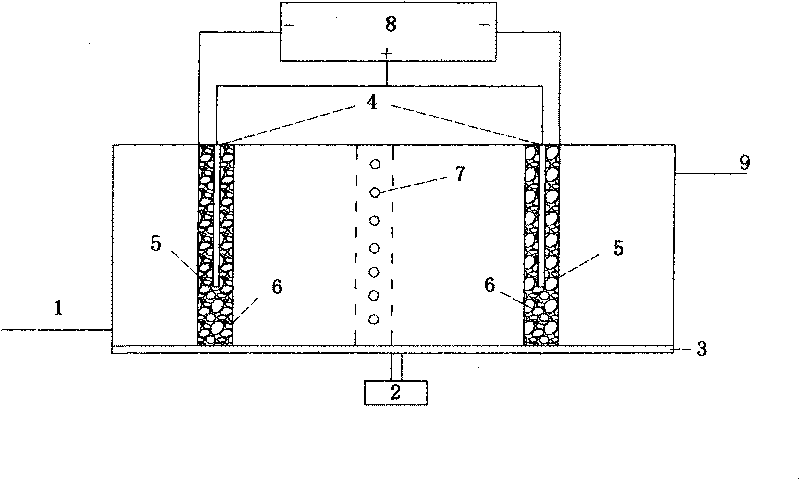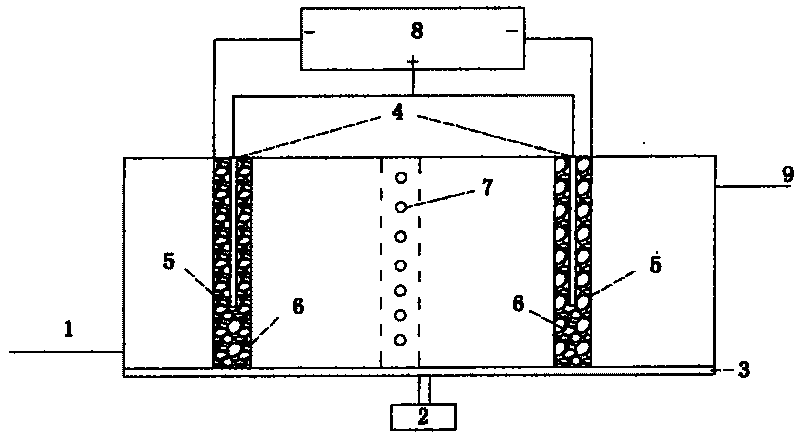Optic-electronics integrated device for treating organic wastewater through catalytic oxidation
A technology of organic wastewater and catalytic oxidation, which is applied in the directions of oxidized water/sewage treatment, water/sewage treatment, light water/sewage treatment, etc. The effect of efficiency
- Summary
- Abstract
- Description
- Claims
- Application Information
AI Technical Summary
Problems solved by technology
Method used
Image
Examples
Embodiment 1
[0019] Use the optoelectronic integrated treatment device of the present invention to treat various scale inhibitors and dispersants, corrosion inhibitors, bactericides and other medicament production wastewater in Tianjin Chemical Industry Research and Design Institute. Under the voltage condition of 10.0V, the COD is 404mg / L when the photoelectric catalytic reaction is 2h Reduction to 38mg / L, the removal rate is 91%, which is higher than the 42% and 33% of ordinary photocatalysis and electrocatalysis, even higher than the sum of the two, and the photoelectric synergy shown by the photoelectric integrated reactor is higher than the separate effects of the two.
Embodiment 2
[0021] Use the photoelectric integrated treatment device of the present invention to treat the water after air flotation treatment in an asphalt plant. Under the voltage condition of 20.0V, the photoelectric catalytic reaction takes 3 hours, and the COD is reduced from 650mg / L to 192mg / L, and the removal rate is 70%. It is higher than 31% and 28% of ordinary photocatalysis and electrocatalysis; the oil content is reduced from 42mg / L to 2mg / L, and the removal rate is 95%, which is higher than 49% and 42% of ordinary photocatalysis and electrocatalysis. high.
Embodiment 3
[0023] Using the photoelectric integrated treatment device of the present invention to treat the secondary biochemical effluent of coking wastewater in a steel factory, under the condition of 20.0V voltage, the photoelectric catalytic reaction takes 2 hours, and the COD is reduced from 236mg / L to 38mg / L, and the removal rate is 84%. It is higher than 41% and 32% of ordinary photocatalysis and electrocatalysis; the phenol content is reduced from 32mg / L to 0.6mg / L, and the removal rate is 98%, which is higher than 57% and 32% of ordinary photocatalysis and electrocatalysis average high.
PUM
| Property | Measurement | Unit |
|---|---|---|
| Remove | aaaaa | aaaaa |
| Removal rate | aaaaa | aaaaa |
Abstract
Description
Claims
Application Information
 Login to View More
Login to View More - R&D
- Intellectual Property
- Life Sciences
- Materials
- Tech Scout
- Unparalleled Data Quality
- Higher Quality Content
- 60% Fewer Hallucinations
Browse by: Latest US Patents, China's latest patents, Technical Efficacy Thesaurus, Application Domain, Technology Topic, Popular Technical Reports.
© 2025 PatSnap. All rights reserved.Legal|Privacy policy|Modern Slavery Act Transparency Statement|Sitemap|About US| Contact US: help@patsnap.com


